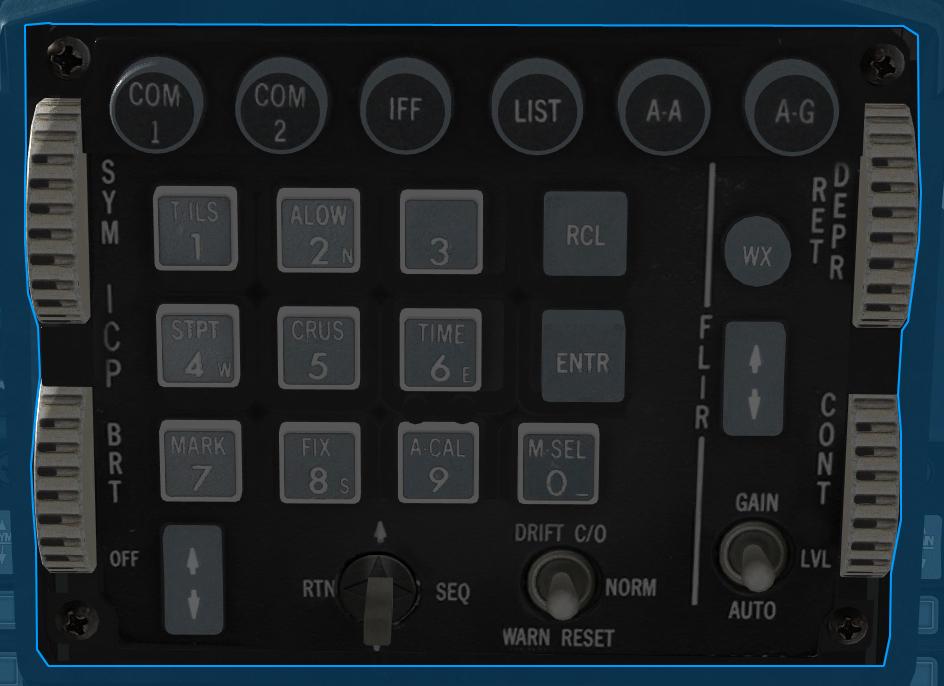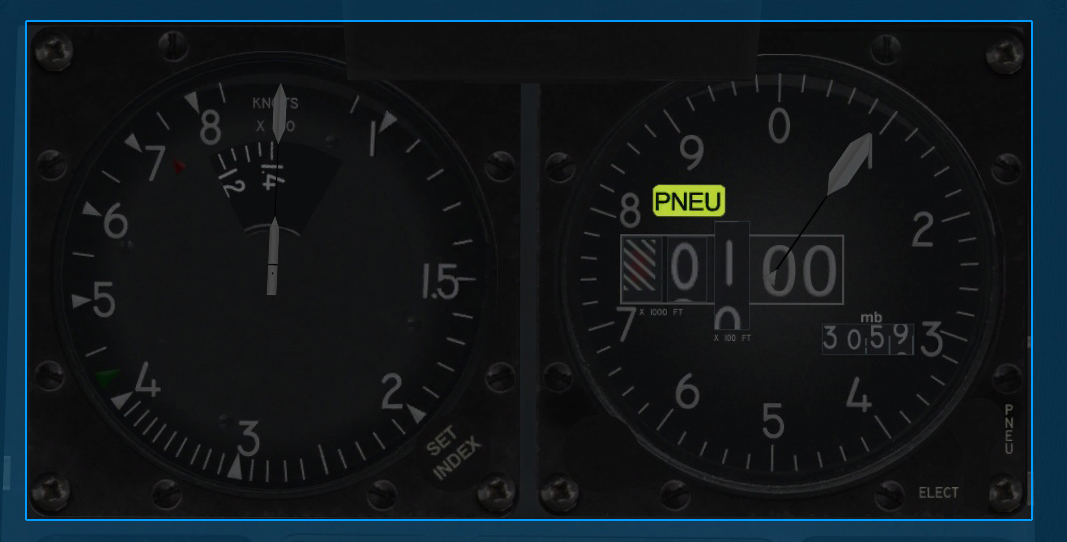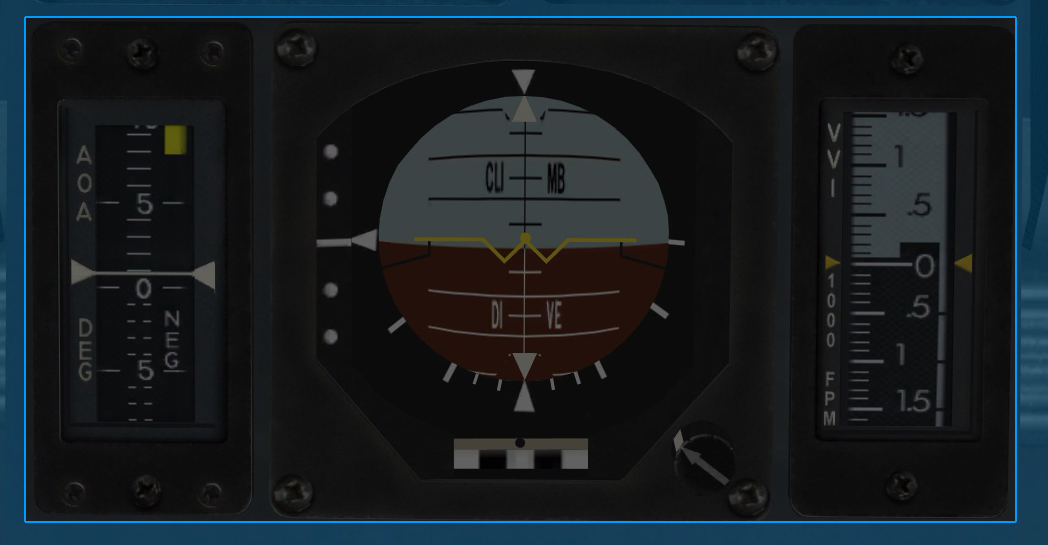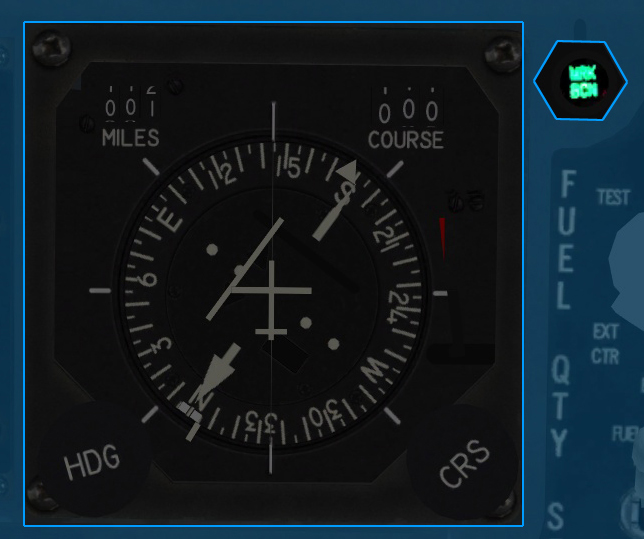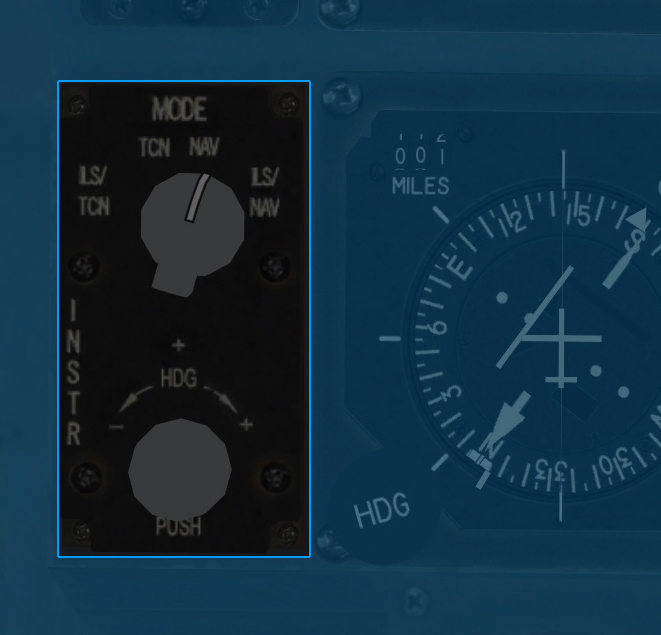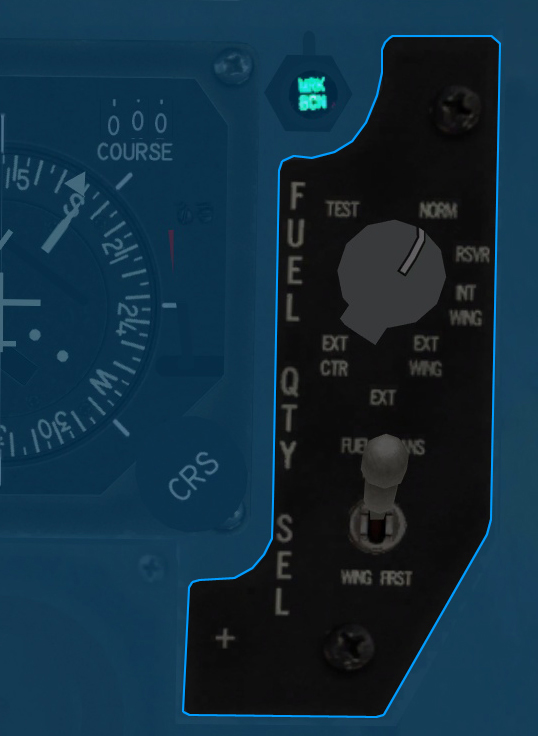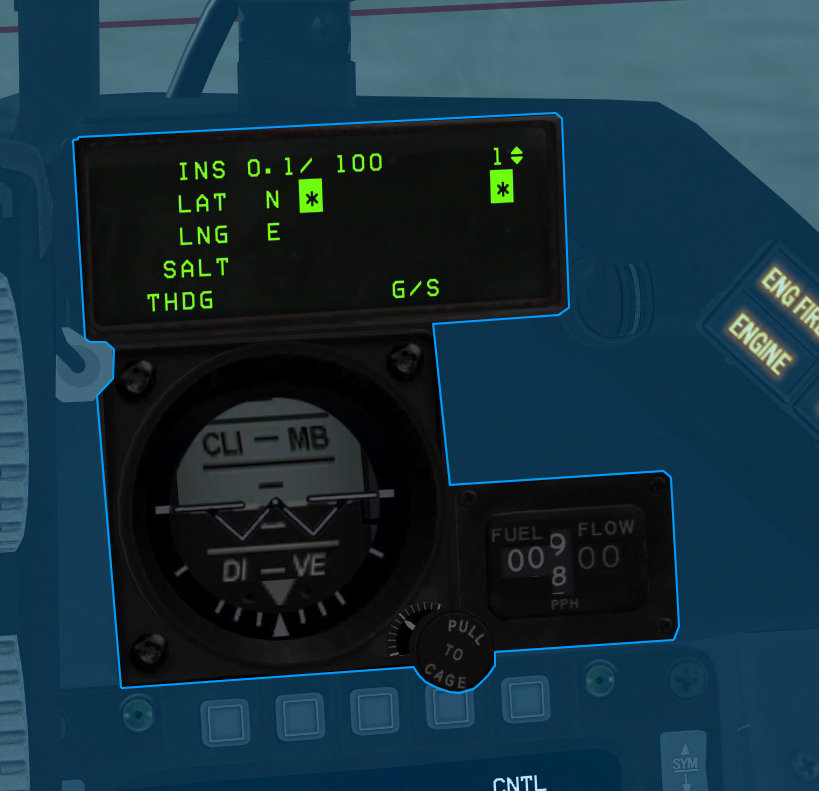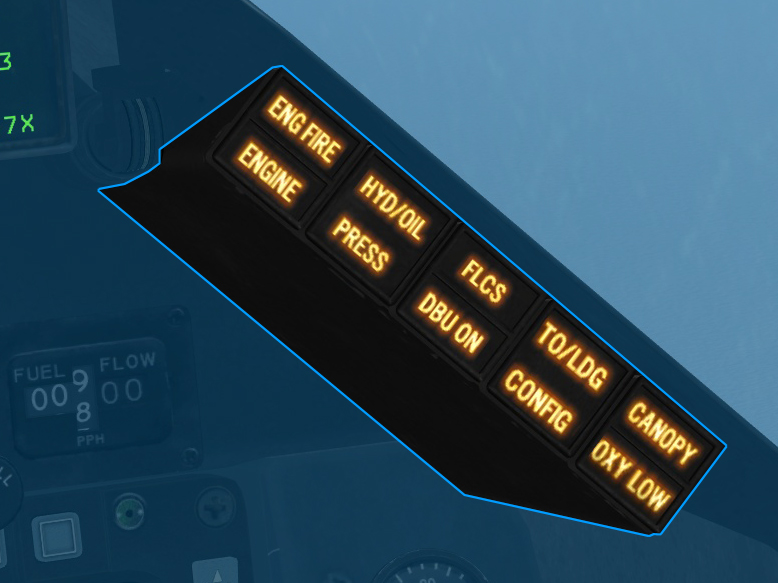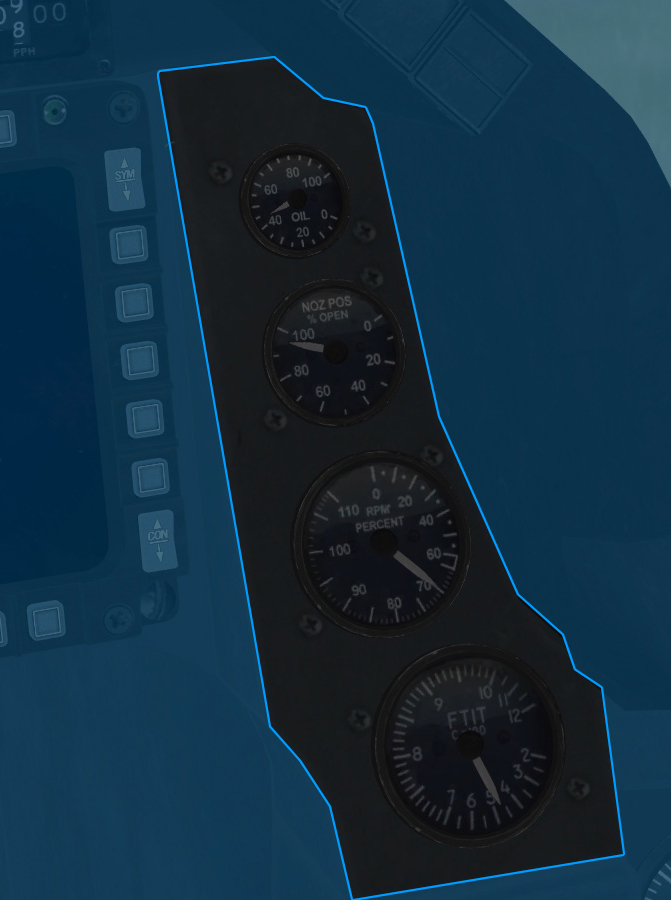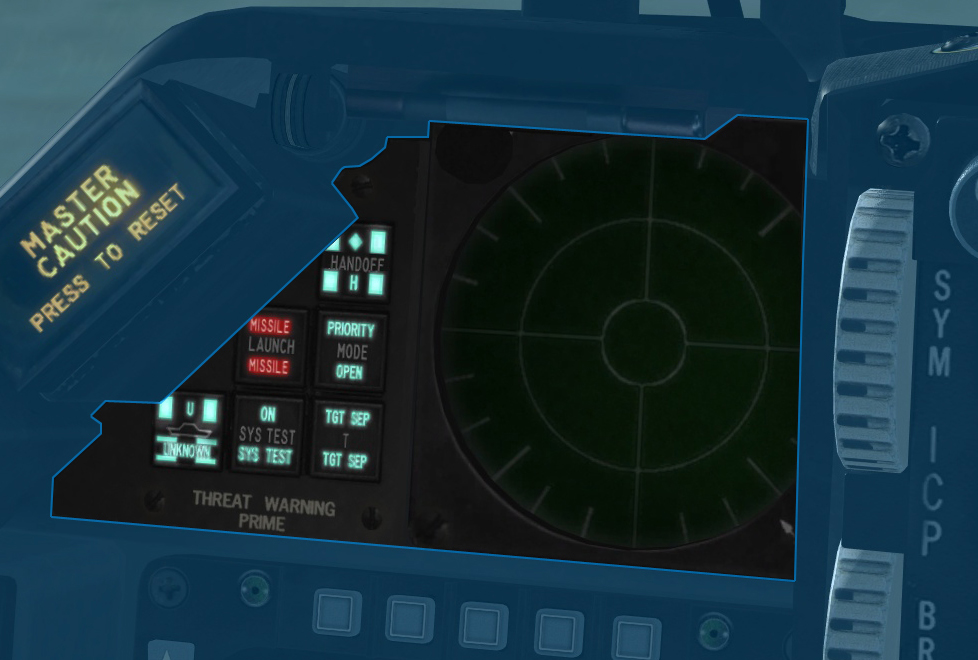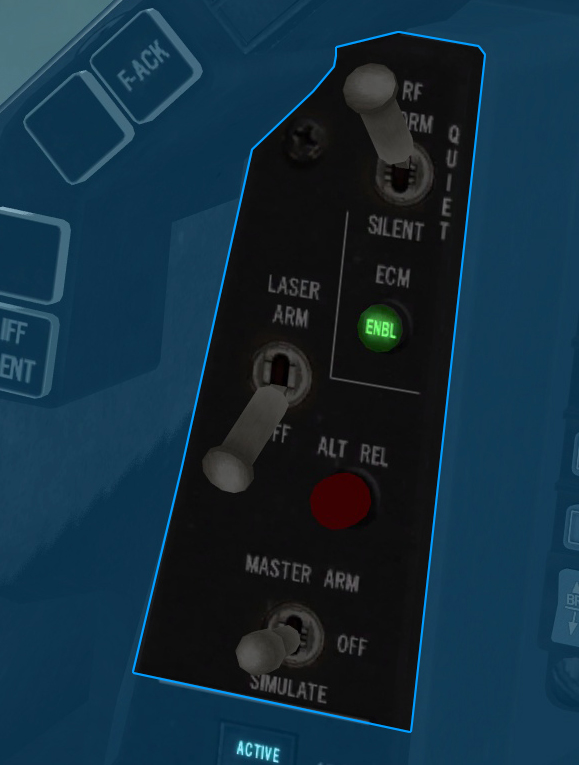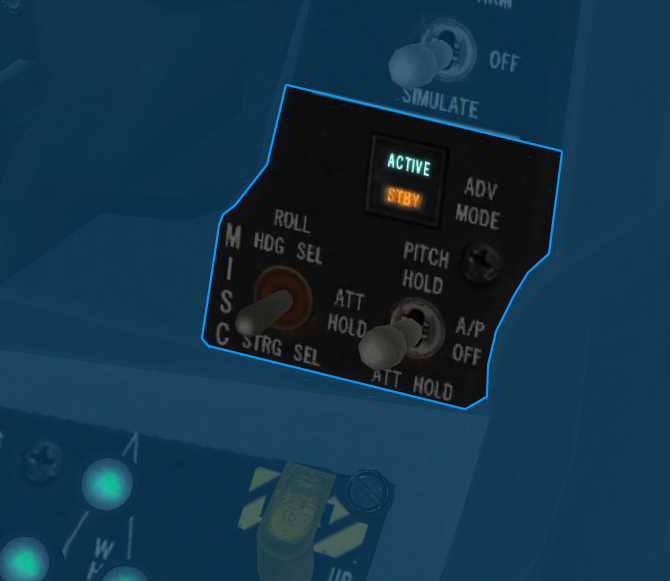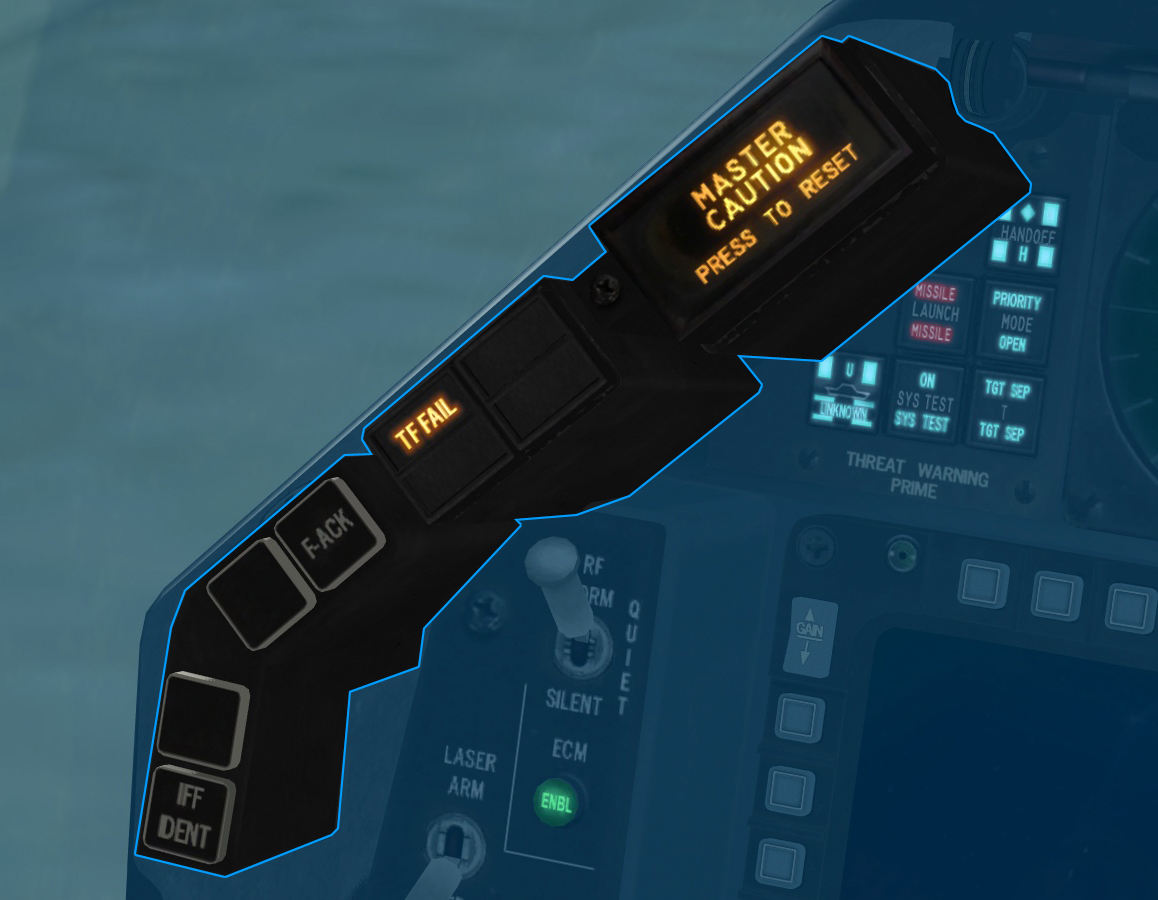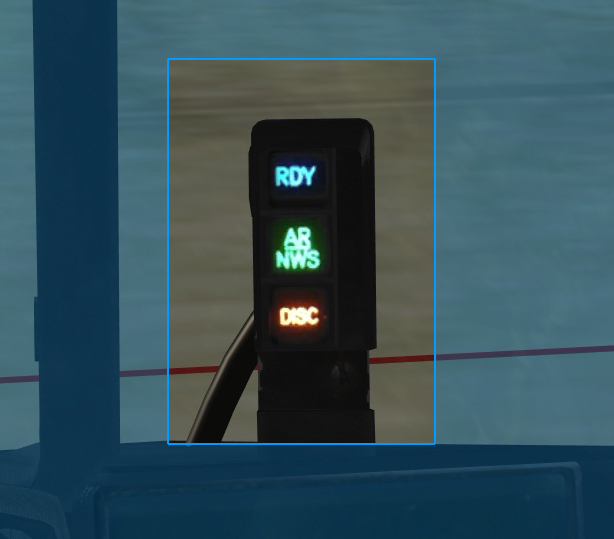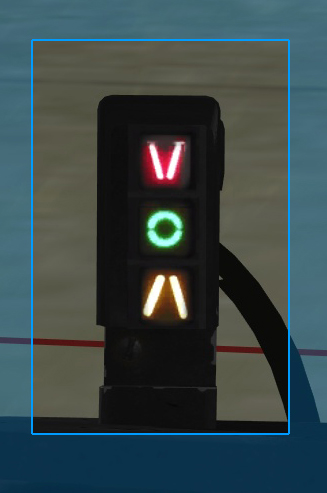Instrument Panel
Contents
ICP
The ICP (Integrated Control Panel) is the centerpiece of the F-16's cockpit, placed right below the HUD. It is part of the UFC (Up-Front Controls) and allows the pilot access to the aircraft's computer for data entry/editing. For now you only need to know about the SYM wheel on the top left and the rocker key below the 7 key. The SYM wheel controls (and turns on) the HUD brightness, and the rocker key is used to cycle through steerpoints. All other functions of the ICP will be covered in the DED section.
Airspeed and Altitude Indicators
- Airspeed Indicator
- The Airspeed Indicator is on the left and indicates Calibrated Airspeed (CAS) in knots (x100). The small window at the top displays Mach number. The SET INDEX knob is not implemented.
- Altitude Indicator
- Displays barometric altitude. The small window displays currently selected barometric pressure and can be set in either Inches of Mercury (in. Hg) or Millibars (mb) via the BMS Configuration (current reads 30.59 in. Hg). The knob on the lower left rotates to change barometric pressure for altimeter adjustment. PNEU indicates that the altimeter is running off of pneumatic pressure instead of electricity. This occurs when the engine is not running and during high-G maneuvering. When PNEU is not visible the altimeter is running off of electrical power.
ADI
The ADI (Attitude Direction Indicator) is located in the center. The bank indicator at the bottom reads 10°, 20°, 30° and 60°. The knob on the lower right is not implemented.
- AoA Indicator
- To the left of the ADI is the AoA (Angle of Attack) indicator, in degrees.
- VVI
- To the right of the ADI is the VVI (Vertical Velocity Indicator), in feet per minute (FPM) (x1000).
HSI
The HSI (Horizontal Situation Indicator) is pretty typical.
- DME
- Located in the top left, the MILES window displays distance from selected STPT (steerpoint) or TACAN. Also known as DME (Distance Measuring Equipment).
- CRS
- Located in the top right, this window displays selected course, which is selected via the CRS knob on the bottom right. Clicking on the right half of the CRS knob will increase/decrease course in increments of 1. Clicking the left half of the CRS knob will increase/decrease course in increments of 5.
- HDG
- Located in the bottom left, the HDG knob selects the heading. The heading bug can be currently seen on North.
- MRK BCN
- MRK BCN is a light that illuminates when passing over the outer and inner markers during an ILS approach.
INSTR MODE Panel
The INSTR MODE panel selects the navigation mode to use in conjunction with the HSI and HUD.
- NAV
- NAV is the typical setting and gives distance, bearing and course deviation to currently selected STPT. For valid course deviation indication the course must be manually inputted via the HSI's CRS knob.
- TCN
- TCN gives distance, bearing, course deviation and to/from indicators (latter not shown) to tuned TACAN station. For valid course deviation indication the course must be manually inputted via the HSI's CRS knob.
- ILS/NAV
- ILS/NAV gives ILS glideslope/localizer bars on the ADI and HUD, and the HSI gives distance, bearing and course deviation to currently selected STPT. For valid course deviation indication the course must be manually inputted via the HSI's CRS knob.
- ILS/TCN
- ILS/TCN gives ILS glideslope/localizer bars on the ADI and HUD, and the HSI gives distance, bearing, course deviation and to/from indicators (latter not shown) to tuned TACAN station. For valid course deviation indication the course must be manually inputted via the HSI's CRS knob.
FUEL QTY SEL Panel
- TEST
- Tests the fuel gauge
- NORM
- Displays current total fuel state in the fuel gauge
- RSVR
- Displays current fuel state of the fore and aft reservoir tanks in the fuselage
- INT WING
- Displays current fuel state of the right and left internal wing tanks
- EXT WING
- Displays current fuel state of the right and left external wing tanks (if available)
- EXT CTR
- Displays current fuel state of the center-line external tank (if available)
- FUEL TRANS Switch
- When up in EXT external tanks will feed first, then when empty the internal tanks will feed.
- When down in WING FIRST the internal tanks will feed first, then when empty the external tanks will feed.
DED
Above the right MFD is the DED (Data Entry Display), SAI (Standby Attitude Indicator) and FUEL FLOW gauge indicating fuel flow in pounds per hour (PPH). The DED will be covered in detail in the DED section of the Wiki. Note the Pull to Cage knob is not implemented.
Right Eyebrow Panel
The right eyebrow panel displays high-importance warning lights that are sometimes referred to as VBLs (Very Bad Lights).
Engine Instruments
- OIL
- Oil Pressure in psi
- NOZ POS
- Nozzle position in percent open
- RPM
- Engine RPM in percent
- FTIT
- Fan Turbine Inlet Temperature in hundreds of degrees Celsius
RWR and TWP
Above the left MFD is the RWR (Radar Warning Receiver) and TWP (Threat Warning Prime) panel. These will be covered in the RWR section of the Wiki.
Arming Panel
This is actually the Misc Panel which includes both arming controls and autopilot controls, but for the purpose of this Wiki I have split the two into the Arming Panel and the Autopilot Panel.
- RF Switch
- Controls emissions from the aircraft
- NORM
- All aircraft emissions are normal and operational
- QUIET
- Places the FCR in standby mode
- SILENT
- Eliminates all emissions: FCR, radar altimeter, jammer, etc. Will cause a TF FAIL warning light on the left eyebrow and a WARN message in the HUD
- ECM
- Will illuminate green with ENBL when the jammer pod has been turned on.
- LASER ARM
- Arms the TGP laser for firing via the first trigger detent. The laser will also automatically fire when employing laser-guided munitions.
- ALT REL
- Alternate Release button if the stick's weapon release button fails
- MASTER ARM
- Arms weapons. Note that in SAFE HUD weapons symbology will not display. HUD weapons symbology will display in SIMULATE however the weapons will remain safe.
Autopilot Panel
- ADV MODE
- Part of the TFR (Terrain Following Radar) suite which is not fully or realistically implemented in current versions of BMS, and thus will be considered not implemented.
- PITCH HOLD (up position)
- Maintains current altitude. Pilot can still manually control banking.
- ATT HOLD (down position)
- Maintains current attitude. Pilot can still manually control banking.
- ROLL HDG SEL
- Steers the aircraft to selected heading on the HSI. Only active if in PITCH HOLD or ATT HOLD.
- ROLL STRG SEL
- Steers the aircraft to selected STPT. Only active if in PITCH HOLD or ATT HOLD.
Left Eyebrow Panel
- MASTER CAUTION
- Pressing the MASTER CAUTION button will extinguish the light but will not clear a fault. It will also extinguish when the fault has been cleared.
- TF FAIL
- Part of TFR suite.
- F-ACK
- Displays faults in the Pilot Fault List (PFL), located on the Right Auxiliary Panel.
- IFF IDENT
- Not implemented.
NWS-AAR Indicator
To the right of the HUD is the NWS-AAR Indicator.
- RDY
- Indicates the air refueling door is open and ready to connect to the tanker boom.
- AR
- Indicates good contact with the tanker boom.
- NWS
- Indicates that NWS (Nose Wheel Steering) is active. Only available when all three landing gear are on the ground.
- DISC
- Indicates disconnect from the Tanker boom.
AoA Indexer
To the left of the HUD is the AoA Indexer
- V
- Indicates AoA greater than 13°. Approach speed too slow when landing.
- O
- Indicates AoA at 13°. On approach speed when landing.
- Λ
- Indicates AoA less than 13°. Approach speed too fast when landing.

